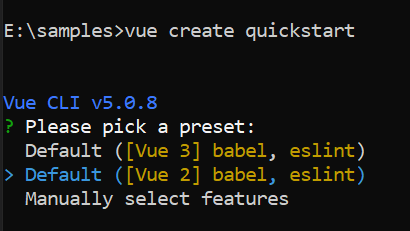Getting Started with the Vue Progressbar Component in Vue 2
25 Apr 20259 minutes to read
This article provides a step-by-step guide for setting up a Vue 2 project using Vue-CLI and integrating the Syncfusion® Vue Progressbar component
Prerequisites
System requirements for Syncfusion® Vue UI components
Dependencies
Below is the list of minimum dependencies required to use the progressbar component.
|-- @syncfusion/ej2-vue-progressbar
|-- @syncfusion/ej2-base
|-- @syncfusion/ej2-data: "*"
|-- @syncfusion/ej2-svg-baseSetting up the Vue 2 project
To generate a Vue 2 project using Vue-CLI, use the vue create command. Follow these steps to install Vue CLI and create a new project:
npm install -g @vue/cli
vue create quickstart
cd quickstart
npm run serveor
yarn global add @vue/cli
vue create quickstart
cd quickstart
yarn run serveWhen creating a new project, choose the option Default ([Vue 2] babel, eslint) from the menu.

Once the quickstart project is set up with default settings, proceed to add Syncfusion® components to the project.
Add Syncfusion® Vue packages
Syncfusion® packages are available at npmjs.com. To use Vue components, install the required npm package.
This article uses the Vue Progressbar component as an example. Install the @syncfusion/ej2-vue-progressbar package by running the following command:
npm install @syncfusion/ej2-vue-progressbar --saveor
yarn add @syncfusion/ej2-vue-progressbarThe –save will instruct NPM to include the chart package inside of the
dependenciessection of thepackage.json.
Import Syncfusion® CSS styles
You can import themes for the Syncfusion® Vue component in various ways, such as using CSS or SASS styles from npm packages, CDN, CRG and Theme Studio. Refer to themes topic to know more about built-in themes and different ways to refer to themes in a Vue project.
The progressbar has different themes. They are:
- Material
- Fabric
- Bootstrap
- High Contrast
import chart component CSS as given below in <style> section of the App.vue file.
<style>
<!-- Material theme used for this sample -->
@import "../node_modules/@syncfusion/ej2-vue-progressbar/styles/material.css";
</style>Add Syncfusion® Vue component
Follow the below steps to add the Vue Progressbar component:
1. First, import and register the Progressbar component in the script section of the src/App.vue file.
<script setup>
import { ProgressBarComponent as EjsProgressbar } from '@syncfuion/ej2-vue-charts';
</script><script>
import { ProgressBarComponent } from '@syncfuion/ej2-vue-charts';
export default {
name: "App",
components: {
'ejs-progressbar': ProgressBarComponent
}
}
</script>2. In the template section, define the Progressbar component with the animation and value property.
<template>
<div>
<div id='loader'>LOADING....</div>
<div id="container">
<div class="row linear-parent">
<div id="percentage" class="linear-progress">
<ejs-progressbar
id="percentage"
type='Circular'
:value='value'
:animation="animation"
>
</ejs-progressbar>
</div>
</div>
</div>
</div>
</template>3. Declare the value for the animation and value properties in the script section.
<script setup>
const value = 100;
const animation= {
enable: true,
duration: 2000,
delay: 0
};
</script><script>
data: function() {
return {
value : 100,
animation: {
enable: true,
duration: 2000,
delay: 0
},
};
}
</script>Here is the summarized code for the above steps in the src/App.vue file:
<template>
<div>
<div id='loader'>LOADING....</div>
<div id="container">
<div class="row linear-parent">
<div id="percentage" class="linear-progress">
<ejs-progressbar
id="percentage"
type='Circular'
:value='value'
:animation="animation"
>
</ejs-progressbar>
</div>
</div>
</div>
</div>
</template>
<script setup>
import { ProgressBarComponent as EjsProgressbar } from "@syncfusion/ej2-vue-progressbar";
const value = 100;
const animation= {
enable: true,
duration: 2000,
delay: 0
};
</script>
<style>
#loader {
color: #008cff;
height: 40px;
left: 45%;
position: absolute;
top: 45%;
width: 30%;
}
#container {
display: -webkit-box;
}
</style><template>
<div>
<div id='loader'>LOADING....</div>
<div id="container">
<div class="row linear-parent">
<div id="percentage" class="linear-progress">
<ejs-progressbar
id="percentage"
type='Circular'
:value='value'
:animation="animation"
>
</ejs-progressbar>
</div>
</div>
</div>
</div>
</template>
<script>
import { ProgressBarComponent } from "@syncfusion/ej2-vue-progressbar";
export default {
name: "App",
components: {
'ejs-progressbar': ProgressBarComponent
},
data: function() {
return {
value : 100,
animation: {
enable: true,
duration: 2000,
delay: 0
},
};
},
provide: {},
methods: {}
}
</script>
<style>
#loader {
color: #008cff;
height: 40px;
left: 45%;
position: absolute;
top: 45%;
width: 30%;
}
#container {
display: -webkit-box;
}
</style>Run the project
To run the project, use the following command:
npm run serveor
yarn run serveModule Injection
Progressbar component are segregated into individual feature-wise modules. In order to use a particular feature, you need to inject its feature service in the AppModule. feature service name and description as follows.
-
ProgressAnnotation- Inject this provider to use Annotation.
This module should be injected to the provide section as follows,
import { ProgressBarComponent, ProgressAnnotationService } from "@syncfusion/ej2-vue-charts";
export default {
components: {
'ejs-progressbar': ProgressbarComponent
},
provide: {
progressbar: [ProgressAnnotationService]
}
};